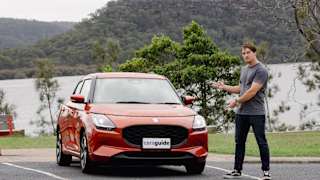Craig Duff track tests and reviews the Toyota 86 with specs, fuel consumption and verdict at the Fuji Speedway race track in Japan.
Never mind drifting — enduro racing hones a cleverer corner-carver.
A high-pitched howl reverberates around the Fuji Speedway short circuit as Keiichi Tsuchiya — better known in Japan as the "Drift King" — sees how well the latest Toyota 86 can slide around a track.
It is familiar territory for Tsuchiya, whose regular drive is a 1986 AE86 Sprinter Trueno, the spiritual predecessor to the Toyota 86/Subaru BRZ. The coupe launched in 2012, like its forebear, has a cult following as an affordable sports car with an emphasis on handling over straight-line hustle.
Tsuchiya's behind the (now smaller) steering wheel because after four years the 86 has earned a midlife update and it amounts to more than the typical front and rear bumper revisions. The most significant changes are concealed under the bodywork and have been adopted from the 86 race car that took part in the Nurburgring 24-hour race.
Chief engineer Tetsuya Tada says the biggest differences are in the chassis, suspension and electronic stability control. The race team stiffened the chassis then softened the suspension to improve cornering grip.
The same principles have been applied to the updated road version and translate into a better handling car that also rides over the bumps with more compliance than the old car.
The 86's ability to hustle through turns — already a strong point — has been notably elevated.
Extra welds around the front struts and roof pillars minimise body flex. Adding 1mm to the diameter of the rear stabiliser bar enabled the engineers to reduce the rear suspension stiffness by 15 per cent.
Tada says the two-stage stability control, which replaces the previous model's Sports mode with a less intrusive Track setting, endows considerable gains in cornering ability. As the software intervenes rather later, he cautions, that setting shouldn't be used on the road.
He also explains that the automatic version couldn't benefit from the small but worthwhile power updates on the manual car. The extra oomph from revising the intake and exhaust manifolds caused the auto occasionally to kick-down and exceed noise limits.
Australia will continue to take GT and GTS variants of the 86 but Toyota Australia's Steve Coughlan says it is too early to set pricing, given the updated model won't go on sale until November. The current model starts below $30,000 but the $35,990 GTS is the bestseller.
The updated GT will pick up the carbon-fibre dash inserts now found on the GTS, along with a smaller steering wheel (another suggestion from the race team) and LED lamps.
The GTS will have microsuede inserts on the top of the door panels and the instrument binnacle. It looks and feels cool and Toyota says it helps the driver by reducing reflections. A multi-instrument display with digital speedo can show G-force data, stopwatch, lap timer and fuel remaining.
On the track
Drifting is out but otherwise the only instruction before we hit the Fuji Speedway short course is "go as hard as you like but don't bin the cars, we need them tomorrow".
Toyota is also confident enough in the new car's abilities to have included a current GT-spec model as a benchmark.
The new car turns in with more precision, has better balance mid-corner and can put the power down earlier on corner exit.
Smart move. A series of back-to-back laps shows acceleration may not have changed appreciably but the 86's ability to hustle through turns — already a strong point — has been notably elevated.
The new car turns in with more precision, has better balance mid-corner and can put the power down earlier on corner exit. That's because the rear end now rolls and squats just enough to keep the rubber on the road rather than trying to skip around the turn.
Track mode permits enough rear-end slide to help drive the car on the throttle without the stability control intervening. The same couldn't be said of the current car's Sports mode, which in comparison kicks in earlier and cuts power much more abruptly.
The updated vehicle also rolls over ripple strips with less vibration, which should mean a smoother ride on public roads.
Toyota 86 2016: GT
| Engine Type | Inline 4, 2.0L |
|---|---|
| Fuel Type | Premium Unleaded Petrol |
| Fuel Efficiency | 7.8L/100km (combined) |
| Seating | 4 |
| Price From | $13,970 - $18,370 |
| Safety Rating |
|
Verdict
A good thing done better, the 86 continues to refine the affordable sports car segment.
Do you agree that the updated 86 is more special than before? Tell us what you think in the comments below.
Click here to see more 2016 Toyota 86 pricing and spec info.
Pricing Guides






.jpg)
.jpg)
.jpg)
.jpg)
.jpg)
.jpg)
.jpg)
.jpg)
.jpg)
.jpg)
.jpg)
.jpg)
.jpg)
.jpg)


.jpg)


.jpg)
_0.jpg)
.jpg)

.jpg)
.jpg)